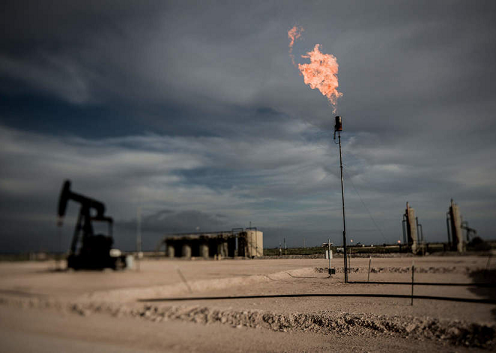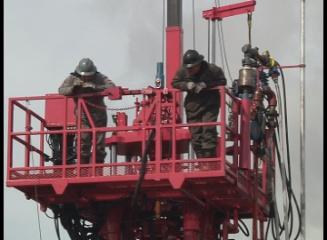
Are Investors Finally Waking up to North America’s Fracked Gas Crisis?
February 12, 2019
Is Drilling and Fracking Waste on Your Sidewalk or in Your Pool?
February 22, 2019By Jim Morris, The Denver Post, December 23, 2018
Parker Waldridge had worked in the Oklahoma oil fields since he was 16 and acquired the traits that make a good driller: fortitude, intellect and a healthy respect for the power of a runaway gas well.
So when Waldridge’s wife, Dianna, heard there had been an accident on a rig he was working near Quinton, in the southeastern corner of the state on Jan. 22, she tried to stay calm. Parker, an independent contractor hired as a well site consultant, was obsessed with safety and had not once expressed fear about a job during their 34year marriage, she told herself.
Still, on the four-hour drive to Quinton from their home in Crescent, north of Oklahoma City, dread began to creep in. Dianna had learned before leaving that Parker was among five men missing after an explosion on Patterson Rig 219, operated by Houston based Patterson-uti. At a church in Quinton, she sat with her four grown daughters, a son-in-law and the other workers’ families, awaiting confirmation of what they suspected: The men weren’t coming back. They would have to be identified through dental records.
Drilling is an inherently dangerous undertaking, with a fatality rate nearly five times that of all industries in the United States combined in 2014, the last year such rates on oil and gas extraction
were published by the government. Production pressures — and the temptation to cut corners — intensify during boom times, as America is experiencing now due to a rush of fossil fuel exports.
The work of coaxing oil and gas from thousands of feet underground is performed in biting cold and breathtaking heat by stoics such as Parker Waldridge, who burned to death at age 60 in a driller’s cabin, known as a doghouse, atop the floor of Rig 219.
“It is a macho world,” said Frank Parker, a safety consultant in Magnolia, Texas, who has studied the industry and its workers for more than 50 years. “They get up in the morning and eat nails for breakfast. We need those people to do that kind of work. We’ve just got to find a way not to kill them.”
From 2008 through 2017, 1,566 workers died from injuries in the oil and gas drilling industry and related fields, according to data from the U.S. Department of Labor’s Bureau of Labor Statistics. That’s almost exactly the number of U.S. troops who were killed in Afghanistan during the same period.
From 2008 through Oct. 25 of this year, the department’s Occupational Safety and Health Administration cited companies in the extraction industry for 10,873 violations, a Center for Public Integrity analysis of OSHA data found. Sixty four percent of the violations were classified by the agency as “serious,” meaning inspectors found hazards likely to result in death or serious physical harm. An additional 3 percent were classified as “repeated,” meaning the company previously had been cited for the hazard, or “willful,” indicating “purposeful disregard” for the law or “plain indifference to employee safety.”
During that period, OSHA investigated 552 accidents resulting in the death of at least one worker. Among these were 11 accidents involving Patterson-uti; OSHA found violations in 10. Initial penalties in the 552 accidents averaged $16,813 but later were reduced, on average, by 30 percent. (OSHA often cuts fines in exchange for quick settlements and hazard abatement.)
Upstream
The number of workers exposed to death, injury and illness in the upstream portion of the oil and gas industry — exploration and production — is growing, especially in the frenetic Permian Basin of West Texas and southeastern New Mexico. At the beginning of December, according to figures from oil field services firm Baker Hughes, the basin accounted for more than half of the nation’s operating drilling rigs — 489 in all.
In Texas, oil and gas extraction firms employ 2,400 more people than they did a year ago. But the real job growth has come in support activities: As of October, companies employed 170,600 derrick operators, rotary drill operators and other workers — 50,000 more positions than at the start of the decade. This puts more workers in the path of bone-crushing machinery, explosive gases and cancer-causing chemicals.
Asked how OSHA is responding, a Labor Department spokesman wrote in an email that enforcement crackdowns, centered on the oil and gas industry, are under way in five regions of the country. (The one covering Texas, Oklahoma and New Mexico officially lapsed in October, but OSHA inspectors are operating as if it were still in effect, the spokesman wrote.)
Nonetheless, the upstream industry is exempt from key OSHA rules that apply to other industries. It does not have to comply, for example, with the process safety management standard, which requires that refineries, chemical plants and other high-hazard operations adopt procedures to prevent fires, explosions and chemical leaks.
OSHA decided not to include upstream in the original standard in 1992 because it had proposed a rule specifically aimed at drilling. That rule was killed by the White House, whose occupant at the time, George H.W. Bush, had run his own oil company in Texas before entering politics. Unnerved by a catastrophic blast at a Texas fertilizer plant in 2013, then-president Barack Obama ordered OSHA to begin the process of updating the rule. The agency sought, among other things, to bring upstream into the fold.
The response was chilly. The International Association of Drilling Contractors said the removal of the exemption would do “little to improve safety,” impose “unnecessary regulatory burdens and ultimately result in Americans being put out of work.” The exemption stayed.
David Michaels, who led OSHA at the time, said he met regularly with upstream leaders and they were not universally opposed to more regulation. Still, trade groups such as the American Petroleum Institute argued for the status quo, pointing to the industry’s relatively low injury rate. Michaels didn’t buy it. “They have a low injury rate because they often don’t report their injuries,” he said in a recent interview. “They have a very high fatality rate, so it’s simply not possible they have a low injury rate.”
The numbers, whatever they are, don’t convey the warlike brutality inflicted in the oil fields when something goes wrong. On Aug. 31, 2017, 38-year-old Juan Vicente De La Rosa was working on a platform above a wellhead in Midland County, Texas, when a cable snapped, freeing heavy blocks that struck De La Rosa and killed him almost instantly.
De La Rosa worked for a well-servicing company called Big Lake Services LLC. Big Lake was hired by the owner and operator of the well, Pioneer Natural Resources USA, a major player on the Texas side of the Permian. A lawsuit filed against both firms by the mothers of De La Rosa’s children alleges the Pioneer representative at the site — the “company man,” in industry parlance — acknowledged to investigators “he had been told that the severed cable was in need of repair.”
OSHA cited Big Lake for a single violation and proposed a $12,805 fine.
“Could have been prevented”
Traumatic injuries like those that killed Parker Waldridge and Juan De La Rosa aren’t the only hazards upstream workers face. Toxic gases — notably hydrogen sulfide, a component of crude oil that carries a distinctive rotten-egg odor — can be just as lethal.
It was hydrogen sulfide, also known as H2S, that took the life of Gregory Claxton, an Iraq War veteran and the father of a 3year-old boy, in Montague County, Texas, on Feb. 14, 2015. Claxton, 29, was a crude hauler for Twin Eagle Transport LLC of Houston. Twin Eagle was a contractor for EOG Resources, a large exploration and production company also based in Houston.
Claxton moved oil by truck from a battery of storage tanks at EOG’S Cooper B Unit, near the unincorporated town of Forestburg, to a pipeline in Wichita Falls, about 70 miles away. It was part of his job to dip a bottle on a rope, known as a thief, into the tanks to collect a sample so the oil’s consistency, or specific gravity, could be ascertained. (The lighter the oil, the more it is worth). He also was to measure the oil’s depth and temperature to calculate the volume in the tank.
On the morning of his death, Claxton climbed onto a catwalk above a tank holding crude from Well 1H. Opening the hatch, he was hit with a wave of H2S. He died so suddenly that his body was found upright, as if frozen in place. After performing an autopsy, a pathologist with the Dallas County medical examiner’s office listed the cause of death as “toxic effects of hydrogen sulfide.”
Gregory’s parents, Randall and Shellye Claxton of Nocona, Texas, have settled a lawsuit against Twin Eagle but are still fighting EOG in court. EOG posted no H2S warning signs at the Cooper B Unit, they claim, and Gregory was given no respiratory protection. Had EOG alerted Twin Eagle to the presence of the deadly gas, Shellye believes, Twin Eagle — lacking the proper safety equipment — would have turned down the job.
“He was a Marine,” she said of her son. “He went to Iraq twice. He was willing to lay down his life for his country, and I just don’t want him to have died in vain. I know these accidents happen, but this could have been prevented.”
An EOG spokesman declined to comment; in a court filing, the company denied the allegations in the pending lawsuit. Twin Eagle reached a settlement with the Claxtons.
Randall, who was hauling crude for Twin Eagle from a different location the day Gregory died, left the oil business after the accident. He said there is a culture of denial on H2S that extends to the Texas Railroad Commission — which regulates oil and gas drilling in the state. “I’ve got a lot of friends who work in the oil field,” Randall said. “Every one of them told me there is no H2S in Montague County. They’ve been lied to.”
The National Institute for Occupational Safety and Health, part of the Centers for Disease Control and Prevention, documented nine worker deaths nationwide during tank gauging between 2010 and 2014. These were likely due, NIOSH said, not to H2S but to inhalation of hydrocarbon gases or vapors or to asphyxiation by breathing oxygen-depleted air.
Other insidious threats lurk in the oil fields, in part because of the upstream industry’s regulatory exceptionalism. The industry, for example, is exempt from a 1987 OSHA rule designed to strictly limit exposure to benzene, a highly volatile, carcinogenic component of crude oil. Instead, it is subject to a far more lenient limit, dating to OSHA’S creation in 1971.
Benzene is often released during “flowback” operations at well sites in which hydraulic-fracturing fluids and volatile hydrocarbons are collected at the surface and sent to tanks or pits. The OSHA exposure limit for benzene in industries such as oil refining is one part per million averaged over an eight-hour workday. The short-term limit is 5 ppm over any 15-minute period. For upstream companies, the eight-hour ceiling is 10 ppm, and there is no short-term limit.
In a 2014 paper, NIOSH researchers reported finding benzene spikes above 200 ppm during sampling of flowback operations in Colorado and Wyoming. That’s enough to cause symptoms such as dizziness, headaches, tremors, confusion, rapid or irregular heartbeat and unconsciousness.




